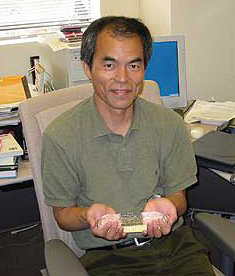Blue light-emitting diodes (LEDs) are really bright. Too bright for theorists to handle, in fact. Why? Because, the materials from which they are made usually have impurities that should make their glow much duller. Now, an international team of researchers has discovered why this is the case.
Commercially viable blue LEDs are based on the wide band gap semiconductor gallium nitride and indium gallium nitride and were invented by Shuji Nakamura then at the Nichia Corporation in 1993. By the late 1990s, they were widely available and now sit in an important technological niche in the development of large full-colour displays, LEDs for highly energy-efficient solid-state lighting to replace incandescent bulbs, and 400 nanometre laser diodes for optical data storage in high definition DVDs. However, the commonly used indium gallium nitride can only be manufactured at relatively low quality with high levels of impurities. Theoretically at least these impurities should quench the light the device produces, but it does not.

Shuji Nakamura
Nakamura now at the University of California Santa Barbara, Shigefusa Chichibu of Tsukuba University and their colleagues there and in Japan have now used positron annihilation spectroscopy to demonstrate rather ingeniously that the blue light emitted from these LEDs originates from structures within the device consisting of only a few atoms. Until now, these structures had not been observed experimentally. The researchers suggest that their findings agree with an older model of structures formed from just three indium atoms in a chain, alternating with nitrogen, that is, In-N-In-N-In, rather than more recent interpretations
In future, such tiny atomic arrangements might be created deliberately to help microelectronics manufacturers achieve highly efficient light emission in other materials without having to be too concerned about the presence of impurities. Such a development will allow inferior and defective crystals to be used thus bringing down production costs and reducing the overall manufacturing energy load in precluding certain purification steps.

Lighting up technology with materials (Credit: Piccolo Namek)
Nakamura received, Finland’s Millennium Technology Prize on 15th June 2006 for his original development of blue LEDs from nitride materials in the early 1990s.
Further reading
Nature Mater, 2006 in press
http://dx.doi.org/10.1038/nmat1726
Shuji Nakamura
http://www.materials.ucsb.edu/LINKS/PROFnakamura/
Nichia Corporation
http://www.nichia.co.jp/about_nichia/
Suggested searches
light emitting diodes